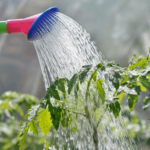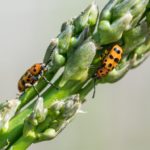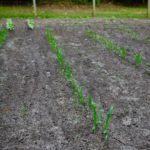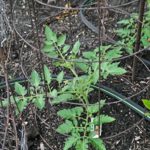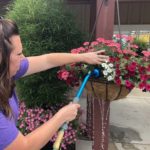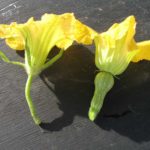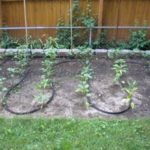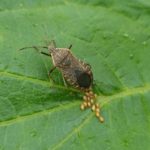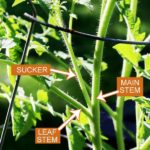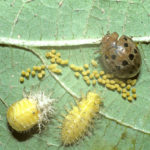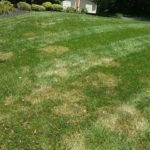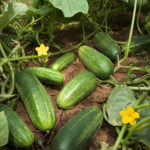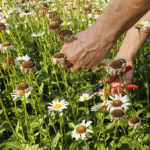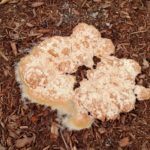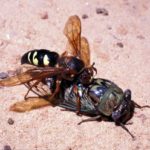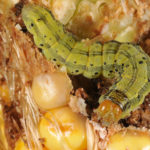Donna’s Garden Tips for June
go.ncsu.edu/readext?697813
en Español / em Português
El inglés es el idioma de control de esta página. En la medida en que haya algún conflicto entre la traducción al inglés y la traducción, el inglés prevalece.
Al hacer clic en el enlace de traducción se activa un servicio de traducción gratuito para convertir la página al español. Al igual que con cualquier traducción por Internet, la conversión no es sensible al contexto y puede que no traduzca el texto en su significado original. NC State Extension no garantiza la exactitud del texto traducido. Por favor, tenga en cuenta que algunas aplicaciones y/o servicios pueden no funcionar como se espera cuando se traducen.
Português
Inglês é o idioma de controle desta página. Na medida que haja algum conflito entre o texto original em Inglês e a tradução, o Inglês prevalece.
Ao clicar no link de tradução, um serviço gratuito de tradução será ativado para converter a página para o Português. Como em qualquer tradução pela internet, a conversão não é sensivel ao contexto e pode não ocorrer a tradução para o significado orginal. O serviço de Extensão da Carolina do Norte (NC State Extension) não garante a exatidão do texto traduzido. Por favor, observe que algumas funções ou serviços podem não funcionar como esperado após a tradução.
English
English is the controlling language of this page. To the extent there is any conflict between the English text and the translation, English controls.
Clicking on the translation link activates a free translation service to convert the page to Spanish. As with any Internet translation, the conversion is not context-sensitive and may not translate the text to its original meaning. NC State Extension does not guarantee the accuracy of the translated text. Please note that some applications and/or services may not function as expected when translated.
Collapse ▲Continue to pinch back garden mums to insure bushy growth until mid-July
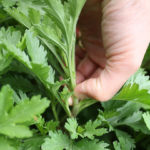
Pinching back mums
Be on the lookout for Japanese beetles. Apply Sevin (carbaryl) frequently to infested plants.
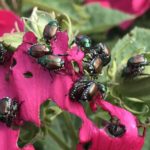
Japanese Beetles
Water plants early in the day. Late day watering encourages diseases.
Watch for asparagus beetles. Pick off or spray with Neem if infestation is severe.
As the temps rise, make sure that plants are watered early in the day This will prevent heat stress on tender transplants. Repeated wilting of water-stressed plants can cause many problems including lack of fruit set and flower drop.
As corn and beans emerge, be sure and thin the seedlings to insure air movement between plants. This will prevent diseases. Space corn at 12 inches and beans at 4 inches.
Stake or cage tomatoes before they bend to the ground. This will give bigger harvests and will also prevent diseases. Be sure to anchor cages in to the ground.
As hanging baskets get larger, they will require more water. Some plants such as New Guinea Impatiens and ferns will require water twice a day during hot weather.
Deadhead flowers in the garden as they fade. This will encourage additional flowering at a quicker rate. Not all flowers require deadheading but roses, geraniums, marigolds, hydrangeas and most perennials will benefit from it.
Squash plants have both male and female flowers on the same plant but they don’t always start flowering at the same time. If you have flowers but no squash be patient-the male flower is sometimes a little late but you’ll have squash to harvest before too long!
A soaker hose laid in the vegetable or flower garden makes watering a breeze. Set it on a timer and you’re good to go. It also conserves water and soaks the plants deeply.
Squash bugs are attacking squash and cucumber plants and they can quickly kill a good plant. Spray with Pyrethrin sprays, making sure to get into the dense foliage at the center of the plant. Repeat every 7-10 days.
Sucker tomatoes when suckers are 4-6 inches long. Plant suckers in the ground or pit them in water. You’ll have a late crop of tomatoes that didn’t cost a penny.
Mexican Bean Beetles are showing up on green beans by mid-June. Pick off coppery egg masses and bristled larvae. Be sure and check the undersides of the leaves. Use liquid Sevin or Spinosad (organic). Both can cause harm to honeybees so spray late in the evening when honeybees are no longer foraging.
Prune “bleeder” trees in June and early July. Bleeder trees drips large amounts of sap in the spring and fall. While this does no damage, it is unsightly. Common bleeder trees are maple, birch, elm and honey locust.
Brown patch (large irregular patches of dead turf grass) is showing up in lawns as the weather heats up. Apply a fungicide containing azoxystrobin once a month.
Cucumbers are prolific bearers and are a favorite low maintenance crop for home gardeners. They tend to get bitter as the summer progresses, however. Keeping them evenly hydrated along with regular feeding can help prevent this not-so-tasty problem.
Most perennials don’t flower all summer long. A good way to get increased flowering is regular deadheading. Most perennials will put on another flush of flowers if deadheading is done regularly.
With the onset of hot and humid weather, slime mold or dog vomit mold is showing up in mulched beds everywhere. While not exactly a mold or fungus it is unsightly and can spread quickly. It is not damaging and can easily be scooped up and disposed of in a garbage bag. It can also be washed away with the water hose. There are no chemicals available for controlling slime mold but it usually disappears with a weather change.
The cicadas will be here soon and along with them comes the Cicada Killer wasp. Although it is large and mean looking, it is a very social solitary wasp. It digs a hole and lays its eggs and begins capturing cicadas to feed to its newly hatched young. You’ll see pencil-size holes in areas of bare ground. Cicada Killers don’t sting and will go away after a few weeks. Control isn’t practical. Just leave them alone and all will be well.
As corn begins to silk, start applying carbaryl (liquid Sevin) to the silk area to prevent corn ear worms. Apply at 3-5 day intervals until silks turn brown. Do this and prevent those horrible caterpillars from invading your corn ears!





